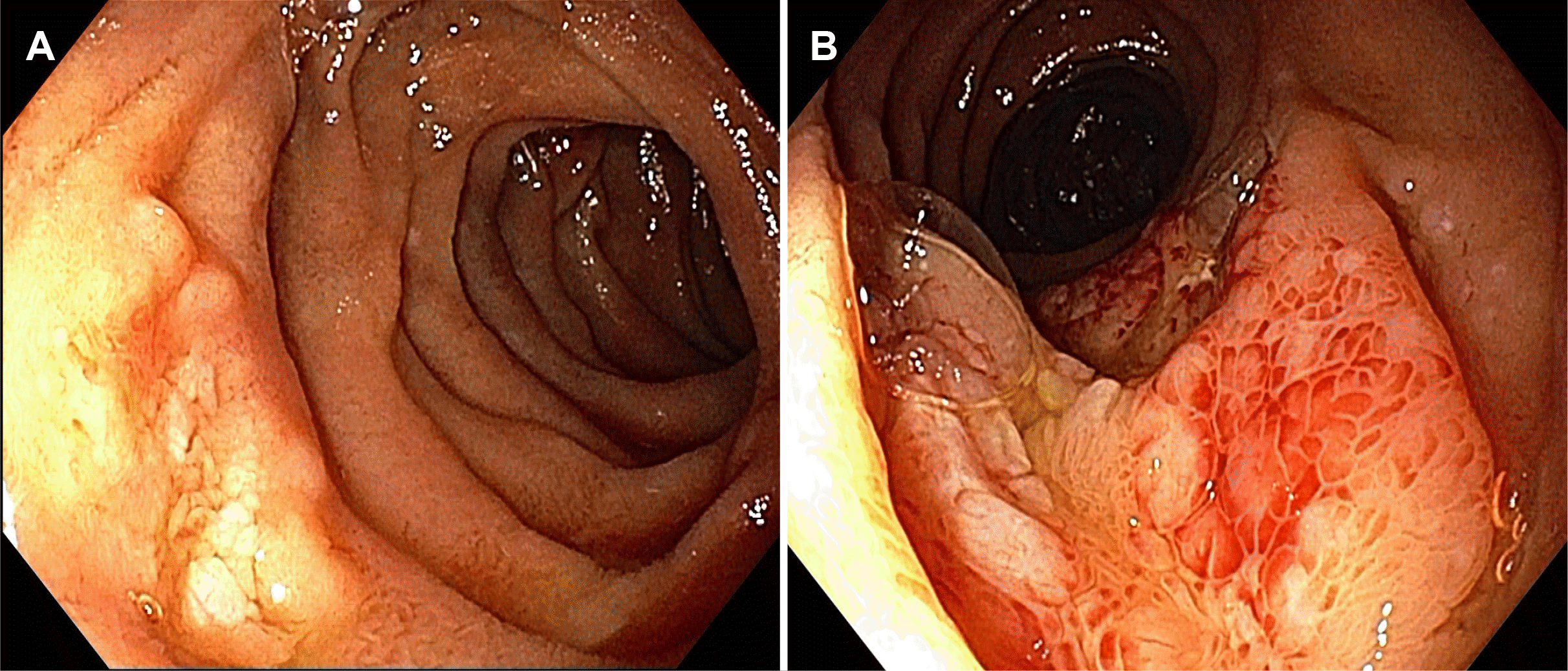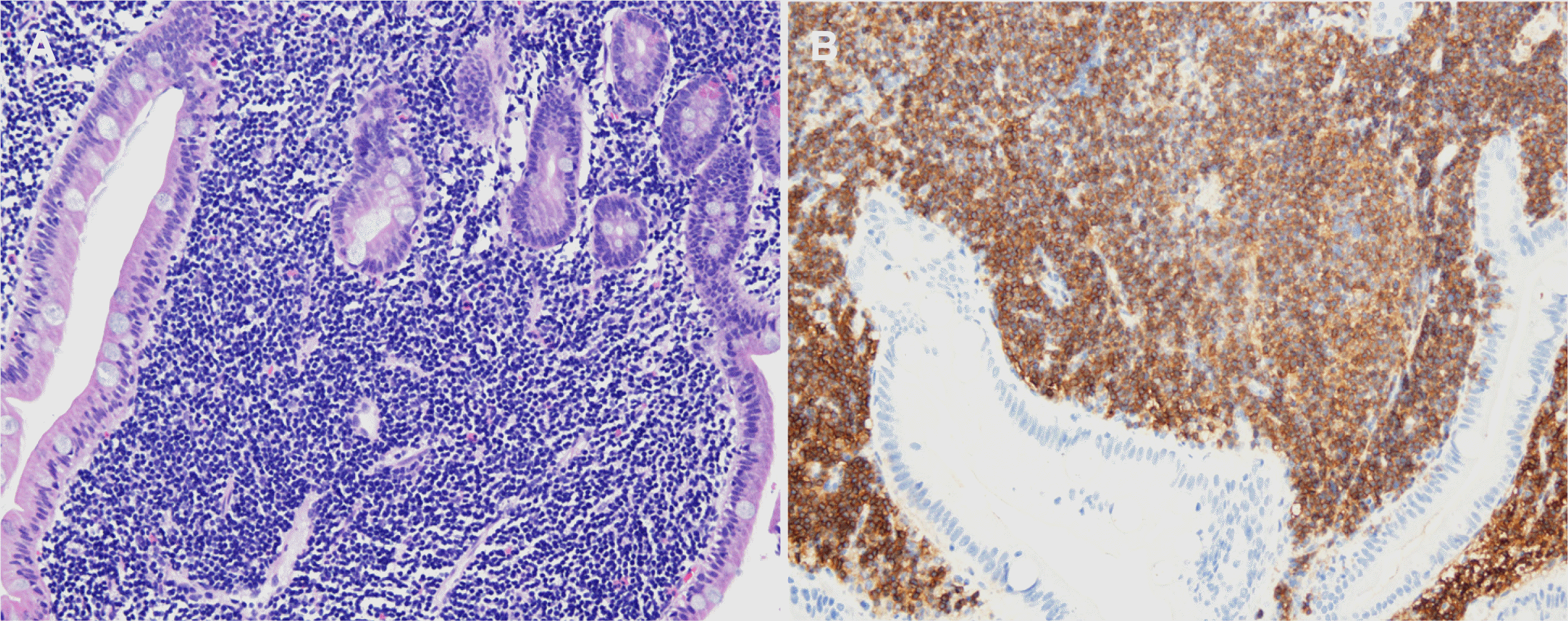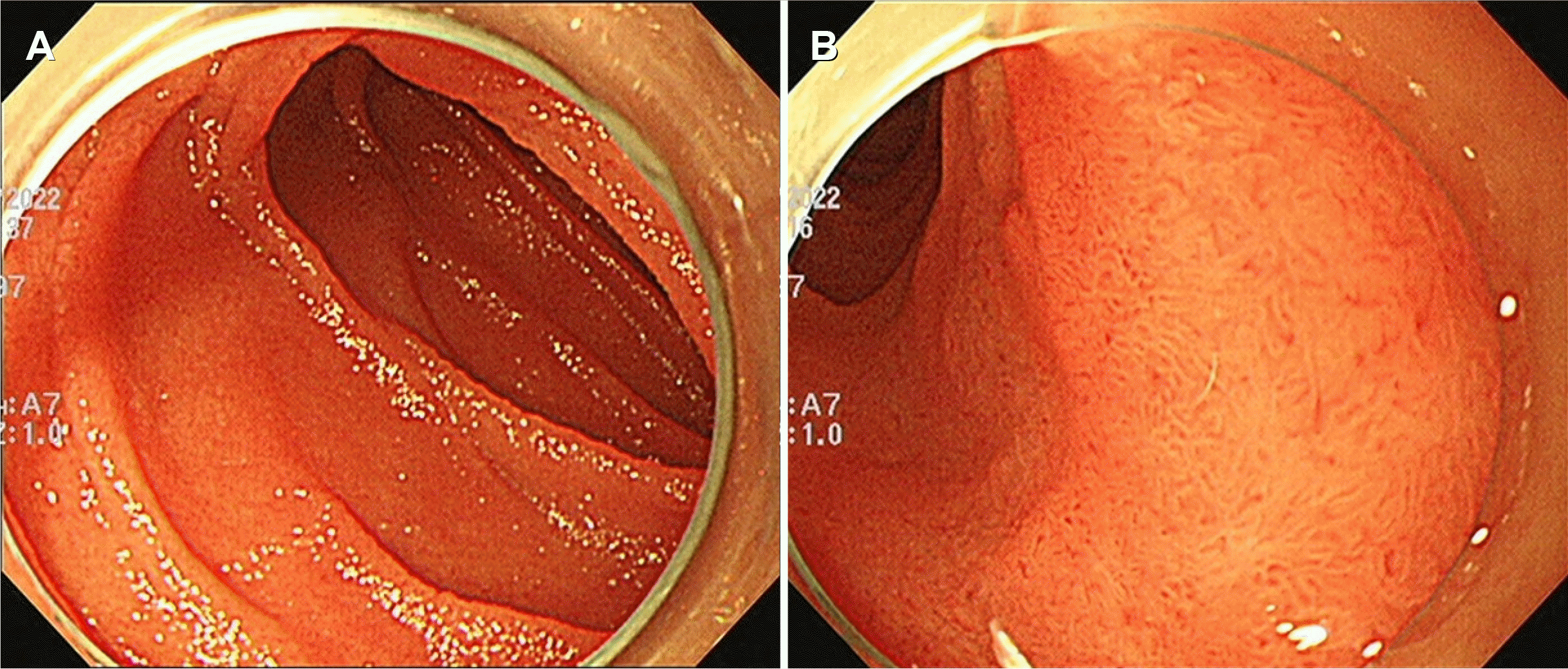Abstract
Primary mucosa-associated with a lymphoid tissue (MALT) lymphoma is a rare distinct subtype of non-Hodgkin’s lymphoma that occurs in approximately 8% of all non-Hodgkin lymphomas. Primary gastrointestinal MALT lymphoma usually occurs in the stomach, but duodenal involvement is extremely rare. Therefore, the clinical manifestations, treatment, and prognosis of primary duodenal MALT lymphoma have not yet been validated because of its rarity. This paper reports a case of a 40-year-old male with primary duodenal MALT lymphoma who was treated successfully with radiation therapy alone. A 40-year-old male visited for a medical check-up. Esophagogastroduodenoscopy revealed whitish multi-nodular mucosal lesions in the second and third portions of the duodenum. Biopsy specimens from mucosal lesions in the duodenum were reported to be suspicious for MALT lymphoma of the duodenum. He received a total dose of 3,000 cGy in 15 fractions with external beam radiation therapy for three weeks. Three months after radiation therapy, an endoscopic examination revealed complete resolution of the duodenal lesions. The follow-up 12 months after radiation therapy showed no evidence of tumor recurrence.
Primary gastrointestinal lymphoma accounts for approximately one-third of extranodal non-Hodgkin’s lymphomas and a small proportion of gastrointestinal malignancies. The most common subtypes of primary gastrointestinal lymphoma are diffuse large B-cell lymphoma and mucosa-associated lymphoid tissue (MALT) lymphoma.1-3 Primary MALT lymphoma is a rare distinct subtype of non-Hodgkin’s lymphomas, occurring in approximately 8% of all non-Hodgkin lymphomas.4-6 Most primary gastrointestinal MALT lymphomas occur in the stomach, and duodenal involvement is extremely rare.7,8 Therefore, the clinical manifestations, treatment, and prognosis of primary duodenal MALT lymphoma have not been validated because of its rarity.
This paper reports a case of a 40-year-old male with MALT lymphoma arising in the duodenum that was treated successfully with radiation therapy alone, along with a review of the relevant literature.
A 40-year-old male visited the authors’ clinic for a medical check-up. He had no past medical history. He denied any gastrointestinal and systemic B symptoms or signs, such as abdominal pain, nausea, vomiting, fever, night sweats, and weight loss. He was afebrile, and his blood pressure and pulse rates were normal. His abdominal examination was unremarkable. The findings included a soft and non-tender abdomen, no hepatosplenomegaly, and no palpable superficial lymph nodes. The laboratory examinations revealed the following findings: white blood cell count 5,400/mm3 (normal range: 6,000–10,000/mm3), hemoglobin 15.7 g/dL (normal range: 12–16 g/dL), platelet count 161,000/mm3 (normal range: 130,000–450,000/mm3), blood urea nitrogen 12.6 mg/dL (normal range: 8–23 mg/dL), creatinine 0.85 mg/dL (normal range: 0.5–1.3 mg/dL), serum albumin 4.5 g/dL (normal range: 3.0–5.0 g/dL), aspartate aminotransferase 26 U/L (normal range: 5–37 U/L), alanine aminotransferase 21 U/L (normal range: 5–40 U/L), alkaline phosphatase 57 U/L (normal range: 39–117 U/L), or lactate dehydrogenase 335 IU/L (normal range: 218–472 IU/L). Total bilirubin was 0.89 mg/dL with a direct fraction of 0.21 mg/dL (normal range: 0.2–1.2/0.05–0.3 mg/dL). Serum carcinoembryonic antigen was within normal limits. Esophagogastroduodenoscopy showed whitish multi-nodular mucosal lesions in the second and third portions of the duodenum. The polymerase chain reaction test for Helicobacter pylori (H. pylori) DNA showed negative (Fig. 1A, B). The histological examinations, including hematoxylin–eosin staining, showed dense infiltration of atypical lymphoid cells with lymphoepithelial lesions in the duodenal mucosa (Fig. 2A). The immunohistochemical examination showed that tumor cells were positive for the B-cell marker CD20 (Fig. 2B) and negative for CD3 and Bcl-6. The biopsy specimens indicated MALT lymphoma of the duodenum. Contrast-enhanced neck, chest, abdomen, and pelvis CT, PET-CT, and bone marrow aspiration revealed negativity for lymphoma involvement. The tumor was diagnosed as primary duodenal MALT lymphoma and classified as stage IE according to the Ann Arbor staging classification. A discussion with the multidisciplinary medical team, including a medical oncologist, radiation oncologist, gastroenterologist, and surgeon, led to the decision to perform radiation therapy. The patient received a total dose of 3,000 cGy in 15 fractions with involved site external beam radiation therapy for three weeks. Three months after the completion of radiation therapy, the esophagogastroduodenoscopy and pathologic examination revealed complete resolution of the duodenal lesions (Fig. 3A, B). The patient has been on a regular follow-up schedule at the outpatient clinic. The serial follow-up exams with a biopsy at three months and 12 months after radiation therapy revealed no evidence of tumor recurrence. Informed consent was obtained from the patient for publication.
MALT lymphoma is an extranodal marginal zone B cell lymphoma arising from MALT in various organs, including the gastrointestinal tract, salivary gland, parotid gland, lung, thyroid gland, thymus, skin, bladder, mammary gland, and lacrimal gland.4-6 The stomach is the most common site of gastrointestinal MALT lymphoma involvement, but duodenal involvement is extremely rare.7,8 Therefore, little is known about the clinical data, presenting manifestations, treatment, or prognosis of primary duodenal MALT lymphoma owing to its rarity.
Two reports from USA and Korea revealed the mean age at diagnosis of duodenal MALT lymphoma to be 56.2 years (range 20–78) in USA9 and 49.7 years (range 20–72) in Korea.10 The gender ratio was 11 males:15 females in USA,9 and seven males: six females in Korea.10 Duodenal MALT lymphoma can be asymptomatic in the early stages, but it may induce abdominal discomfort or pain, vomiting, hematemesis, melena, and occasionally outlet obstruction according to the lesion type, location, size, and degree of obstruction.9,10 The most common site was the bulb, followed by the second portion and multiple sites. The main endoscopic feature was a nodular or polypoid lesion, followed by ulceration, granular lesion, and mass.9,10 In the present case, a 40-year-old man with asymptomatic MALT lymphoma arising from the second and third portions of the duodenum, which presented as whitish multi-nodular mucosal lesions were found incidentally on health screening endoscopy.
Previously, duodenal MALT lymphomas were treated with various modalities, including single or combination of H. pylori eradication, surgery, chemotherapy, or radiation therapy.9,10 Despite this, the complete remission rates in patients with duodenal MALT lymphoma have been disappointing compared to gastric MALT lymphoma patients.10 The treatment and outcome of duodenal MALT lymphoma are not yet well established because of its rarity.
Gastric MALT lymphoma is associated strongly with H. pylori infection, and H. pylori eradication is a well-known standardized therapy for gastric MALT lymphoma.7,8 Although some reports have shown that H. pylori eradication alone was effective for treating duodenal MALT lymphomas,11-14 the association between duodenal MALT lymphoma and H. pylori infection is unclear. A comparison report of 13 duodenal MALT lymphomas and 130 gastric MALT lymphomas showed that the H. pylori infection rates were less than half in duodenal MALT lymphomas.10 In the present case, duodenal MALT lymphoma was not associated with a H. pylori infection. Some reports have shown that a duodenal MALT lymphoma was resistant to H. pylori eradication therapy.15,16
Radiation therapy is associated with better survival and lower mortality in patients with early-stage or localized MALT lymphomas arising in the gastrointestinal tract and other organs, compared to other treatment options and modalities, such as surgical resection or chemotherapy.4-8,17 Therefore, radiation therapy may be a feasible and safe treatment, allowing organ preservation and avoiding toxicity, morbidity, and mortality, which are associated with aggressive surgical resection or chemotherapy in early and localized duodenal MALT lymphoma. In the present case, definitive treatment with involved site radiation therapy was planned by a discussion with the multidisciplinary medical team because the lesion was localized to the duodenum alone and was detected early. Early detection was achieved by closely examining the duodenum 2nd to 3rd portions, which is easily missed, especially during a routine medical examination. Three months after radiation therapy, endoscopic examination with biopsy for pathologic examination revealed complete resolution of the duodenal lesions. Twelve months after radiation therapy, the patient had not developed any tumor recurrence. On the other hand, it was difficult to accurately target the lesion in radiation therapy because the small intestine is movable and not fixed in the abdominal cavity. Further study will be necessary to determine the long-term efficacy and probability of normal tissue complications of this treatment approach.
REFERENCES
1. Foukas PG, Bisig B, de Leval L. 2021; Recent advances upper gastrointestinal lymphomas: molecular updates and diagnostic implications. Histopathology. 78:187–214. DOI: 10.1111/his.14289. PMID: 33382495.
2. Shirwaikar Thomas A, Schwartz M, Quigley E. 2019; Gastrointestinal lymphoma: the new mimic. BMJ Open Gastroenterol. 6:e000320. DOI: 10.1136/bmjgast-2019-000320. PMID: 31645987. PMCID: PMC6782046.
3. Olszewska-Szopa M, Wróbel T. 2019; Gastrointestinal non-Hodgkin lymphomas. Adv Clin Exp Med. 28:1119–1124. DOI: 10.17219/acem/94068. PMID: 31414733.
4. Di Rocco A, Petrucci L, Assanto GM, Martelli M, Pulsoni A. 2022; Extranodal marginal zone lymphoma: pathogenesis, diagnosis and treatment. Cancers (Basel). 14:1742. DOI: 10.3390/cancers14071742. PMID: 35406516. PMCID: PMC8997163.
5. Rodríguez-Sevilla JJ, Salar A. 2021; Recent advances in the genetic of MALT lymphomas. Cancers (Basel). 14:176. DOI: 10.3390/cancers14010176. PMID: 35008340. PMCID: PMC8750177.
6. Violeta Filip P, Cuciureanu D, Sorina Diaconu L, Maria Vladareanu A, Silvia Pop C. 2018; MALT lymphoma: epidemiology, clinical diagnosis and treatment. J Med Life. 11:187–193. DOI: 10.25122/jml-2018-0035. PMID: 30364585. PMCID: PMC6197515.
7. Thieblemont C, Zucca E. 2017; Clinical aspects and therapy of gastrointestinal MALT lymphoma. Best Pract Res Clin Haematol. 30:109–117. DOI: 10.1016/j.beha.2017.01.002. PMID: 28288705.
8. Ishikawa E, Nakamura M, Satou A, Shimada K, Nakamura S. 2022; Mucosa-associated lymphoid tissue (MALT) lymphoma in the gastrointestinal tract in the modern era. Cancers (Basel). 14:446. DOI: 10.3390/cancers14020446. PMID: 35053607. PMCID: PMC8773811.
9. Carman R, Snyder J, Davidson M. 2011; Primary mucosa-associated lymphoid tumor lymphoma of the duodenum: a rare presentation of non-Hodgkin's lymphoma. J Clin Oncol. 29:e226–229. DOI: 10.1200/JCO.2010.31.9525. PMID: 21205760.
10. Na HK, Won SH, Ahn JY, et al. 2021; Clinical course of duodenal mucosa-associated lymphoid tissue lymphoma: Comparison with gastric mucosa-associated lymphoid tissue lymphoma. J Gastroenterol Hepatol. 36:406–412. DOI: 10.1111/jgh.15157. PMID: 32573049.
11. Ochi M, Tominaga K, Okazaki H, et al. 2006; Regression of primary low-grade mucosa-associated lymphoid tissue lymphoma of duodenum after long-term treatment with clarithromycin. Scand J Gastroenterol. 41:365–369. DOI: 10.1080/00365520500331224. PMID: 16497629.
12. Nagashima R, Takeda H, Maeda K, Ohno S, Takahashi T. 1996; Regression of duodenal mucosa-associated lymphoid tissue lymphoma after eradication of Helicobacter pylori. Gastroenterology. 111:1674–1678. DOI: 10.1016/S0016-5085(96)70032-X. PMID: 8942749.
13. Kamura M, Matsui K, Kokubo Y, et al. 2000; [A case of the mucosa-associated lymphoid tissue lymphoma in the duodenal bulb improved rapidly by eradication of Helicobacter pylori for 4-years]. Gastroenterol Endosc. 42:164–168. Japanese.
14. Nakamura S, Matsumoto T, Nakamura S, et al. 2001; Duodenal mucosa-associated lymphoid tissue lymphoma treated by eradication of Helicobacter pylori: report of 2 cases including EUS findings. Gastrointest Endosc. 54:772–775. DOI: 10.1067/mge.2001.119602. PMID: 11726860.
15. Woo KH, Kim JH, Yoon SB, et al. 2007; Duodenal mucosa-associated lymphoid tissue lymphoma: a case report. Korean J Intern Med. 22:296–299. DOI: 10.3904/kjim.2007.22.4.296. PMID: 18309692. PMCID: PMC2687664.
16. Xiang Z, Onoda N, Ohira M, et al. 2004; Mucosa-associated lymphoid tissue lymphoma of the duodenum: report of a case resistant to Helicobacter pylori eradication. Hepatogastroenterology. 51:732–735.
17. Wu Y, Liu X, Imber BS, et al. 2022; Influence of age on long-term net survival benefit for early-stage MALT lymphomas treated with radiotherapy: A SEER database analysis (2000-2015). Radiother Oncol. 173:179–187. DOI: 10.1016/j.radonc.2022.05.034. PMID: 35667572.
Fig. 1
Esophagogastroduodenoscopy shows whitish multi-nodular mucosal lesions in the second (A) and third portions (B) of the duodenum.





 PDF
PDF Citation
Citation Print
Print





 XML Download
XML Download